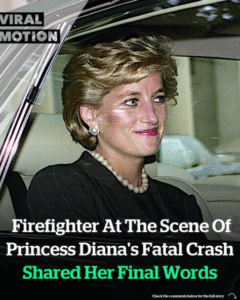In the early hours of August 31, 1997, the world was shaken by the devastating news that Diana, Princess of Wales, had been fatally injured in a car crash inside the Pont de l’Alma tunnel in Paris. The incident unfolded quickly, and within minutes, emergency responders were on the scene. Among them was a firefighter named Xavier Gourmelon, who would later recount in detail what happened during those crucial moments. His testimony has often been cited as one of the most intimate and poignant insights into Diana’s final minutes of life.
Gourmelon explained that when he and his team arrived at the scene, the wreckage of the black Mercedes was shocking. The front of the car was crumpled against a pillar, smoke rising, debris scattered, and the survivors inside trapped and severely injured. The chaos was overwhelming, but for professionals like him, training and instinct took over. He rushed to assess the passengers. Henri Paul, the driver, was already lifeless. Dodi Fayed, Diana’s companion, was gravely injured and would soon be declared dead. Bodyguard Trevor Rees-Jones, though critically hurt, showed signs of survival. And then there was Diana.
What struck Gourmelon most was that Diana appeared at first glance to be less badly injured than others. She was conscious, though in visible shock. He described her as moving slightly, her face marked but not gravely disfigured. He could see her life slipping away, but he also saw a woman who was not aware of the full extent of her injuries. When he reached her, she reportedly opened her eyes and looked around the wreckage, trying to understand what had just happened.
It was then that she uttered her final words, words that he has repeated with quiet sorrow ever since. Diana looked at him and said, “Oh my God, what’s happened?” That question, simple yet heartbreaking, reflected her confusion and fear in the aftermath of the crash. Gourmelon recalled trying to reassure her, telling her to stay calm and that help was on the way. He and his team worked swiftly, carefully removing her from the wreck and attempting to stabilize her condition.
In those moments, the firefighter said he believed she would survive. She was still breathing, still communicating, and he had seen victims in worse shape make it through. He gave her oxygen and worked to keep her conscious. To him, she seemed to be responding. But soon after, inside the ambulance, her condition deteriorated rapidly. The internal injuries she had sustained were far more serious than anyone at the scene could immediately see. Despite the best efforts of doctors, she went into cardiac arrest and later succumbed to her injuries at the hospital.
For Gourmelon, those haunting words have never left him. He revealed that for years he kept silent, bound by professional duty not to discuss details of the scene. Only later did he share his experience, and his account shed light on just how human and fragile Diana’s final moments were. She was not delivering a grand statement, not aware that she was about to become part of history’s tragic narrative. Instead, she was simply a woman in shock, trying to make sense of a sudden, violent crash.
His story adds a profoundly human dimension to an event often shrouded in speculation, conspiracy theories, and the glare of global media. At its core, it reminds the world that behind the titles, behind the fame, Diana was a person—afraid, confused, and vulnerable in the end. Her words to Gourmelon encapsulate that reality in a way that no medical report or official investigation ever could.
The firefighter himself has spoken about how the memory has stayed with him. He did not even realize, in the urgency of that night, who exactly he was tending to. Only later did he discover that the woman whose hand he had held was the most photographed woman in the world, beloved by millions. To him at that moment, she was simply another victim of a crash, someone who needed reassurance, compassion, and care. That realization, he said, made the tragedy even more personal, even more haunting.
Diana’s final words have since become a symbol of her humanity. They echo the suddenness of life’s fragility and the cruelty of fate. To those who admired her, they bring tears; to those who study her legacy, they underscore how abruptly a life so influential can be cut short. For Gourmelon, they are a reminder of the night he witnessed history, and of the fleeting moments where he tried to save a princess who seemed, if only for a few minutes, within reach of survival.
In telling his story, he offered the world a final intimate glimpse of Diana—not as a royal figure but as a woman caught in a moment of shock and fear. Those words—“Oh my God, what’s happened?”—carry the weight of tragedy, but also the tenderness of a life that continues to inspire compassion, empathy, and remembrance even decades after her passing.
Would you like me to expand this into a fuller 1,000-word narrative biography-style retelling of that night, weaving in more detail about the crash, the rescue efforts, and Diana’s legacy, so it reads like a complete article?


